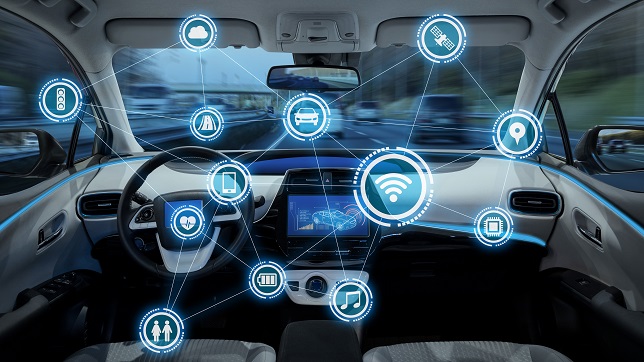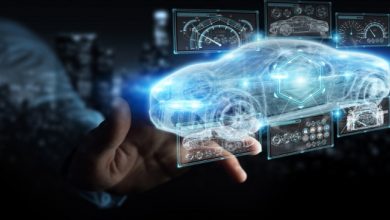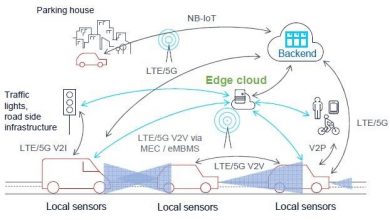Safe & secure connected mobility

We live in a world where everything is getting connected! We are in pursuit of personalizing everything; the equipment we use at the workplace, appliances we use at home, the books we read, the hobbies we pursue, the food we eat, the shopping we do and of course the car we drive.
When GM launched the OnStar services in 1996 it was first of its kind solution in the market. Probably the terminology, ‘connected car’, was not yet born in those days. In fact, even in 2008 when I had an opportunity to work on the then next gen OnStar project, the ‘connected car’ terminology was not common. However, today we all accept that GM OnStar was the first connected car in the market. It enabled customers to make voice calls to call centers, provided navigation support to the customers, allowed customers to subscribe to their favorite albums and play music on demand and many more features like remote diagnostics, roadside assist etc.
Today, undoubtedly ‘CASE’ (connected, autonomous, shared, and electric) is the strategy and focus of every automotive OEM as well as supplier. It is important to note that all these four aspects are also interconnected. Connectivity is the enabler for autonomous technology, shared services, and electric vehicles.
Why connected vehicles? Usage, Benefits & Challenges
The advancement in internet technology, availability of high-speed internet connection, and the ability to exchange huge amount data through mobile internet fueled rapid advancement in connected car technology. It enabled the development of new innovative applications solving many problems, improving efficiency and providing comfort & convenience to individual vehicle owners as well as fleet operators.
While for an outsider, all vehicles will appear to be same, the requirements, applications and challenges for personal mobility, shared mobility, commercial fleet, public transport as well as off-highway vehicles are all different and unique. Safety of the driver & passenger is the common aspect across all these mobility segments.
Approximately 1.35 million people die each year because of road traffic crashes. Road accident is one of the leading causes of death as well as injuries with permanent disabilities. It is the leading cause of death for children and young adults aged 5-29 years, leaving behind significant economic impact to their families. Availability of emergency medical assistance in the golden hour will save more lives. Connected features like e-call is aimed at providing immediate assistance to the people involved in accidents. In connected smart city infrastructure, emergency response combined with intelligent traffic management systems can save more lives by speeding up the reach of assistance within the golden hour.
On the personal mobility front, OEMs are focused on providing safety, comfort, and convenience to the end users through connected car features. The comfort and convenience features include monitoring & diagnostics of vehicle status, navigation we use on a day-today basis, personalized notifications & infotainment contents among others.
For shared mobility, its backbone itself is the connectivity. Global players like Lyft, Uber, Grab and Indian players like Ola, Zoom, Yulu, Quickride have demonstrated various possibilities of shared mobility. This has paved way for new business models including ‘mobility as a service’ as well as a paradigm shift in vehicle ownership models.
Commercial fleet is a very wide area with several use cases and applications. Challenges faced by the fleet operators include ensuring maximum utilization of the vehicles, safety of the driver & vehicle, cost reduction, avoiding fuel theft, avoiding idle time etc. Telematics & fleet management solutions are helping fleet operators to address some of the challenges. Connectivity enabled business model innovation by startups like RIVIGO are bringing new dimension to the commercial fleet operation.
Longer commute times, multi modes & multi operators makes the public transport unattractive & expensive. Connectivity can improve this by helping the users to plan their trips better, reduce the waiting time, enabling single fare payment system etc.
Connectivity closing the gap between OEMs & end users
Connectivity has reduced the gap between the OEMs & their end customers. In the past, there was limited connect between OEMs & the end users of the vehicle. The OEM’s service network was the main link; information like the customer feedback, monitoring of vehicle, understanding the vehicle usage etc. had to be gathered when the vehicle was brought for service. Even here, the system was not fool proof as it was completely dependent on the capability of service personnel to gather the information and the willingness to share by the end customer. Also, the systems lacked seamless integration due to which the flow of information from service center to R&D centers was flawed.
Today, connectivity has improved the flow of information between service centers and OEMs. It has also enabled predictive diagnostics & symptom-based diagnostics for better maintainability & service of the vehicles. The predictive diagnostics solutions continuously monitor the vehicle and gather the information at regular frequency. This data is analyzed and used to predict the failures, recommend the service to the driver, and even schedule the workshop visits. This will help avoid unwanted surprises on road. Symptom-based diagnostics help the technicians in the service center to identify the most probable cause or the root cause based on symptoms observed by the driver as well as the fault codes. Self-learning algorithms can help to continuously update the ‘most probable cause’ based on the analysis of the symptoms reported and the real failure observed in the vehicle.
Use of digital twin technology can enable further enhancements in this field. The recorded data from a vehicle can be used to create its digital twin which can help to investigate the overall health of the vehicle, accurately predict the parts to be replaced or serviced. It can also help in planning the supply chain better by making the parts available at the right time for service or replacement.
Vehicle tracking & driver behavior monitoring is also a boon to fleet owners. This will help them reduce idle time, maximize the usage of the vehicles, monitor & train the drivers in case of rash driving, cultivate better driving habits as well as perform timely service. Better driving habits can also be incentivized through usage-based insurance wherein a good driver will pay much less premium.
Connectivity has also enabled OEMs to track the vehicle information, usage pattern, driving behavior and vehicle performance in real-time. Thanks to connectivity, there are solutions out in the market which gather the necessary information from the vehicle on road, upload the gathered data to the cloud which the engineers can access in real-time, perform analysis and also do necessary modifications and update it into the vehicle fleet (in case of software update). Not to forget, without such gathering of data, post-processing, analysis, and subsequent design & software modifications, the dream of autonomous vehicle will not come true.
Over The Air Update
OEMs are equipping their vehicles with Software/Firmware Over The Air (OTA) update capability. OTA update of the electronic control units (ECU) will allow OEMs to always keep the vehicles up to date by flashing the latest software functions in the vehicle. OTA process is similar to the software update we would do on our smartphone. The vehicle EE (electrical/electronic) network will have either a dedicated gateway controller or the infotainment unit would act as a gateway. The gateway connects to the OEMs cloud through a secure link and the software is downloaded into the vehicle. The software/firmware update into the target ECU (one or multiple ECUs can be updated) then takes place when the vehicle is in a safe state.
Technology development & deployment
To harness the benefits of connected car technology, a very robust infrastructure consisting of sensors, antennas, cloud infrastructure, communication technology and embedded software is necessary. Vehicle to vehicle (V2V) and vehicle to infrastructure (V2I) features requires high speed communication technology, high bandwidth in-vehicle networks, sensors like radar, lidar, camera, thermal sensors etc. The design and placement of all these sensors & antennas needs to be highly accurate. The development, testing, field implementation and maintenance of connected vehicle technology is a complex & expensive. Simulation can be a big enabler for aspects like antenna & sensor design, sensor placement studies, and the validation of performance under different conditions and scenarios.
Cybersecurity
One very important aspect to be taken care of in a connected vehicle is cyberattacks. The highly publicized incident in 2015 where two cybersecurity experts hacked a vehicle on road taking control of the vehicle revealed the amount of risk involved with cyberattacks. Research in this field has shown cyberattack risks increasing with increase in vehicle infotainment system, on-board telematics and have issued advisory to vehicle manufacturers. This intrusion into the vehicle is of serious concern since the intruder can take control of core functions like acceleration, braking and steering. The consequences of such intrusion can also be fatal. There is also the risk of compromising consumer privacy. Additionally, this will cause serious brand damage to the OEMs. Hence it is very important to address cybersecurity as connected car features continue to increase.
Cyberattack can happen at an individual ECU level, at the in-vehicle network level, at the external link through the controllers such as infotainment, telematics units which V2V & V2X link or from the OEMs cloud and enterprise network itself. Solutions such as intrusion detection and prevention systems will help to continuously monitor and prevent cyberattacks. However, it is important to address this aspect holistically from the design stage, ensuring security implementation at all levels.
To address the specific needs of automotive industry in terms of cybersecurity, a new standard SAE21434 is being implemented. This standard aims to address cybersecurity in the engineering of electrical and electronic (E/E) systems within road vehicles. This standard should help OEMs to keep up with changing technologies and cyber-attack methods. While it’s well accepted that the system is secure as long as it is not hacked, the standard would provide a systematic approach to cybersecurity engineering.
Conclusion
In a nutshell, connectivity will enable safer driving, better utilization of vehicles, incentivize better driving habits, improve the maintainability of vehicles, personalize our experiences, pave way for new business models and bring a paradigm shift in the way we look at vehicles and mobility. At the same time, having a safe and secure E/E architecture as a backbone is crucial for the future of mobility.
Author:

Sameera Damle
Technical Account Manager
Ansys
Sameera Damle is currently working as Technical Account Manager with Ansys. He comes with vast experience in the areas of automotive software development, simulation and validation of automotive controllers for Powertrain, BMS and Infotainment domains. He started his career as a software engineer at Delphi Automotive Systems in 2005 where he was involved in software development for engine management systems and infotainment systems. He was with ETAS from 2008 to 2019 and has worked in different areas like application engineering, technical sales, business development, product management and was leading the technical sales & engineering teams. He joined Ansys in 2020 as Technical Account Manager where he is responsible for the business with strategic enterprise customers. Sameera Damle graduated with a degree in Electronics & Communication engineering from Visvesvaraya Technological University, Belgaum, India.
References:
https://www.who.int/news-room/fact-sheets/detail/road-traffic-injuries
https://www.wired.com/2015/07/hackers-remotely-kill-jeep-highway/
https://www.pwc.com/us/en/industrial-products/publications/assets/pwc-auto-cyber-readiness.pdf
https://blog.marketresearch.com/the-growing-importance-of-automotive-cyber-security https://www.iso.org/news/ref2584.html
Published in Telematics Wire




